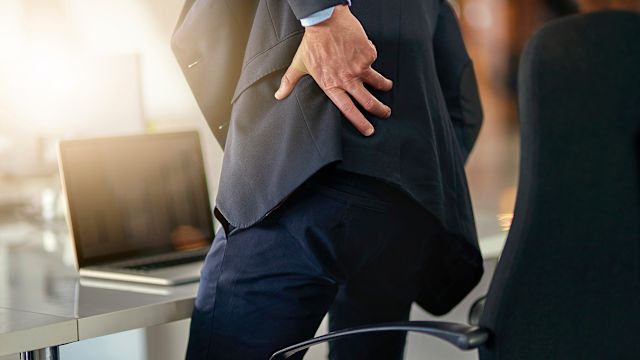Updated on September 22, 2025.
About 4 in 5 adults will have back pain at some point in their lives. For most people, the pain is acute. It goes away within a few days or weeks, often without treatment. When people have back pain that lasts 12 weeks or more, it’s considered to be chronic. It may need treatment, which could include medication, physical therapy, or in some cases, surgery.
People working just about any job are susceptible to back pain, even if the work isn’t particularly strenuous. Office employees and others who sit for most of the day can develop aches, pains, and discomfort related to their occupation. It can occur in different places along the spine, from the neck down to the lower back.
Over time, even something that seems harmless—such as your monitor height—can lead to chronic back pain. To avoid this, be proactive. Take steps to optimize your work setup. Here are some tips to help.
Set up your workstation correctly
You may spend 40 hours a week or more at your desk. Positioning your chair and screen correctly will help you maintain good posture and prevent pain.
“Start with chair height,” says Michael Parsons, FNP-C, a spine specialist in Idaho Falls, Idaho. Your pelvis should be slightly higher than your knees, and your feet flat on the floor. “If you’re short, get a footrest,” he says. A small stack of books will also work.
Screen position is important too, says Parsons. It should be set so that your head is neutral and you’re able to see the screen easily. “Make sure there’s no glare so you don’t have to move your head to see parts of your screen,” Parsons says. “Shoulders should be back and arms should hang naturally, with your elbows below the shoulders.” Keep your wrists level.
Move around
Parsons says people tend to stay in poor posture for most of the day. Getting up and moving around is a chance to reset your body. A good guideline is to get up for a few minutes every half hour. Take a walk, get coffee, do a quick stretch, or say hello to your colleagues.
Limit or avoid repetitive motion
Awkward and repetitive motion puts you at risk for a repetitive strain injury (RSI). “It’s well-known to contribute to back pain,” according to Parsons. Even typing and using a computer can lead to pain and pressure.
To avoid pain, position your computer’s mouse where you can easily get to it. “It should be close to you if you’re going to be reaching for it all day,” says Parsons. Practice good posture and make sure your wrists aren’t leaning on your desk. Consider asking for or purchasing wrist rests, pads that may ease pain in your neck and back.
Talk to the boss
In the United States, back pain costs employers billions of dollars every year. “Most of that is from lost productivity. That’s either money employees are not making, or the company is not making from employees,” Parson says.
Your managers are probably eager to save cash and increase worker productivity. Workstations with better ergonomics might be the answer. For example, see if the organization might invest in standing desks or adjustable-height desks, which can move up and down. While more research is needed, some studies suggest their use can help increase movement and alleviate pain.







